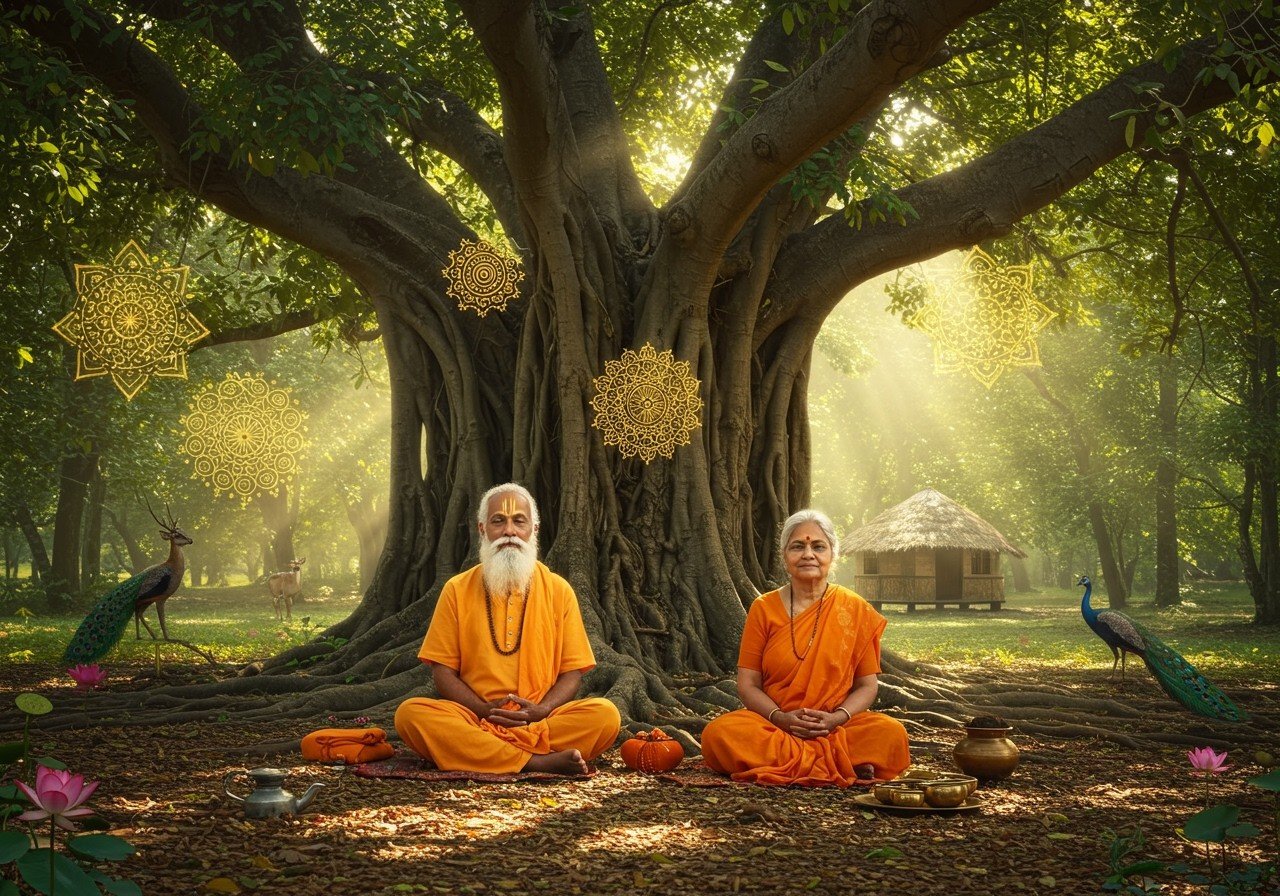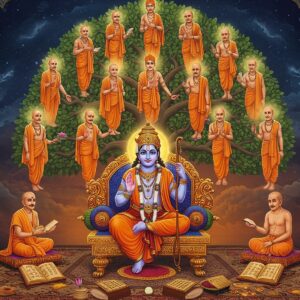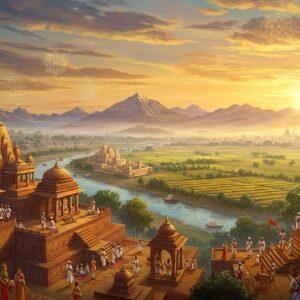
In the journey of life, the Vanaprastha Ashrama marks a significant transition within the traditional Indian Ashrama system. As the third stage, succeeding Grihastha (householder), it signifies a shift in focus from familial and societal obligations towards personal spiritual development. This phase involves embracing simplicity and seeking inner peace, holding profound cultural significance for those who have fulfilled their worldly duties. In contemporary society, many Indians strive to harmonize tradition with modern living, making the principles of Vanaprastha remarkably relevant.
Understanding the Vanaprastha Ashrama
Rooted in Hindu philosophy, Vanaprastha, literally meaning “retiring into the forest,” historically encourages a detachment from material possessions and social responsibilities, redirecting attention towards spiritual pursuits. Ideally, one enters this stage after fulfilling family obligations, preparing for the final stage of Sannyasa (renunciation). The “forest” symbolizes simplifying life and withdrawing from the daily clamor.
A gradual transition into Vanaprastha is key. This involves simplifying one’s life by reducing belongings, lessening social engagements, and prioritizing spiritual practices such as meditation, yoga, and self-reflection. While maintaining meaningful relationships, individuals cultivate mental clarity and inner peace. For those seeking guidance and support during this transition, resources like spiritual retreats and ashram stays can be invaluable.
In modern times, the principles of Vanaprastha can be adapted without requiring a literal retreat to the forest. Creating a “mental forest” involves simplifying one’s surroundings, reducing exposure to excessive media, and engaging in activities like volunteering and lifelong learning. Addressing common misconceptions, such as the need for complete isolation, highlights the flexibility of this life stage.
Organizations like the Vanaprastha Foundation provide valuable support during this transition, offering resources like workshops and retreats. They foster cultural awareness while adapting these ancient traditions to contemporary challenges. Numerous success stories demonstrate the profound benefits individuals gain from such programs.
Vanaprastha: A Journey to Inner Peace
Vanaprastha, the third stage in Hinduism’s Chaturasrama system, translates to “way of the forest.” It represents a pivotal phase in life, emphasizing spiritual growth and detachment from worldly concerns. This stage follows Grihastha and precedes Sannyasa.
Etymology and Meaning
The term “Vanaprastha” combines “vana” (forest) and “prastha” (going to), symbolizing a shift towards solitude and spiritual pursuits. It signifies moving away from material attachments and embracing inner peace and wisdom. This journey often involves exploring ancient scriptures and texts. Resources like explorations of Hindu scriptures offer valuable insights during this time.
Transition from Grihastha
This phase involves handing over family responsibilities to the next generation and transitioning from active involvement in worldly affairs to a more advisory role. The emphasis shifts from material acquisitions to spiritual liberation (Moksha). This can involve the use of tools like prayer beads (mala) for meditation and spiritual practice.
Role in Society
Individuals in the Vanaprastha stage often become counselors and guides, offering wisdom and experience to younger generations. They act as peacemakers, advisors, and keepers of cultural continuity. This role is crucial for societal harmony and passing down traditions. They may even partake in practices like mantra chanting to deepen their spiritual connection.
Adapting to Modern Times
While traditionally involving a physical retreat to the forest, Vanaprastha in modern times represents a partial retirement from worldly life. It emphasizes sharing wisdom and mentoring youth. Maintaining this tradition in today’s fast-paced world presents a challenge but remains essential. Individuals may seek solace and guidance at spiritual locations like the Draksharama Temple.
Optional Path
Vanaprastha, though recommended, is not compulsory. Some individuals transition directly from Brahmacharya (student life) to Sannyasa, dedicating themselves fully to spiritual pursuits. This flexibility acknowledges individual paths to spiritual fulfillment.
Embracing Simplicity
Embracing simplicity during Vanaprastha yields profound benefits, including deeper self-awareness and a stronger connection with the divine. Practically, it reduces stress and enhances overall well-being. Mindful consumption and prioritizing experiences over material possessions contribute to a balanced life. Using simple items like a meditation mat can enhance these practices.
The Role of Foundations
Organizations like the Vanaprastha Foundation play a vital role in supporting individuals transitioning into this life stage. Through workshops, retreats, and educational resources, they facilitate cultural awareness and adapt ancient traditions to modern challenges.
How Poojn.in Supports Your Vanaprastha Journey
Poojn.in provides valuable support for those entering Vanaprastha through a curated collection of spiritual items. Our platform offers tools and resources for simplified spiritual practices, aligning with the teachings of detachment and inner peace. Explore our collection of Puja items, incense, and other spiritual tools to enhance your journey.
Finding Fulfillment in Vanaprastha
Vanaprastha is more than just a life stage; it’s an opportunity to embrace simplicity, find inner peace, and deepen your spiritual connection. By stepping back from worldly demands, individuals can connect more profoundly with themselves and the divine. This journey not only enriches personal lives but also strengthens the fabric of society by passing wisdom and guidance to younger generations. In our fast-paced world, the teachings of Vanaprastha offer a path to balance, health, and spiritual growth, reminding us that true fulfillment lies not in material possessions but in inner harmony and mindful living.
Frequently Asked Questions about Vanaprastha
What is Vanaprastha? Vanaprastha, the third ashrama in Hindu dharma, signifies a transition from worldly responsibilities to spiritual pursuits. It’s a time for introspection, self-discovery, and preparation for the final stage, Sannyasa. This stage involves simplifying one’s life and focusing on inner growth.
Why is it important? Vanaprastha facilitates a gradual detachment from material possessions and social obligations, allowing individuals to focus on their spiritual development. It’s a crucial step in achieving Moksha, or liberation, and offers an opportunity to give back to society through wisdom and guidance.
How do I transition into it? The transition involves gradually reducing material possessions, lessening social engagements, and prioritizing spiritual practices. It’s about finding a balance between fulfilling remaining responsibilities and dedicating more time to self-reflection, meditation, and other spiritual disciplines.
Is it relevant in modern times? Absolutely. While traditionally involving retiring to a forest, Vanaprastha’s principles can be adapted to modern life by creating a ‘mental forest,’ simplifying one’s surroundings, and focusing on inner peace amidst the complexities of the world.
Is it only for the elderly? Though traditionally associated with older age, the principles of Vanaprastha can be applied by anyone seeking a more balanced and spiritually focused life, regardless of age.
What are the benefits? Embracing Vanaprastha can lead to greater inner peace, improved mental clarity, a deeper connection with one’s spirituality, and a more fulfilling life. It also allows individuals to contribute to society by sharing their wisdom and experience.
How does it relate to family? During Vanaprastha, family relationships continue, but the focus shifts towards guidance and support rather than active involvement in daily affairs. It allows individuals to share their accumulated wisdom and life lessons with younger generations.


